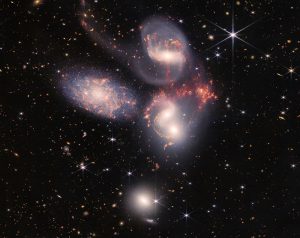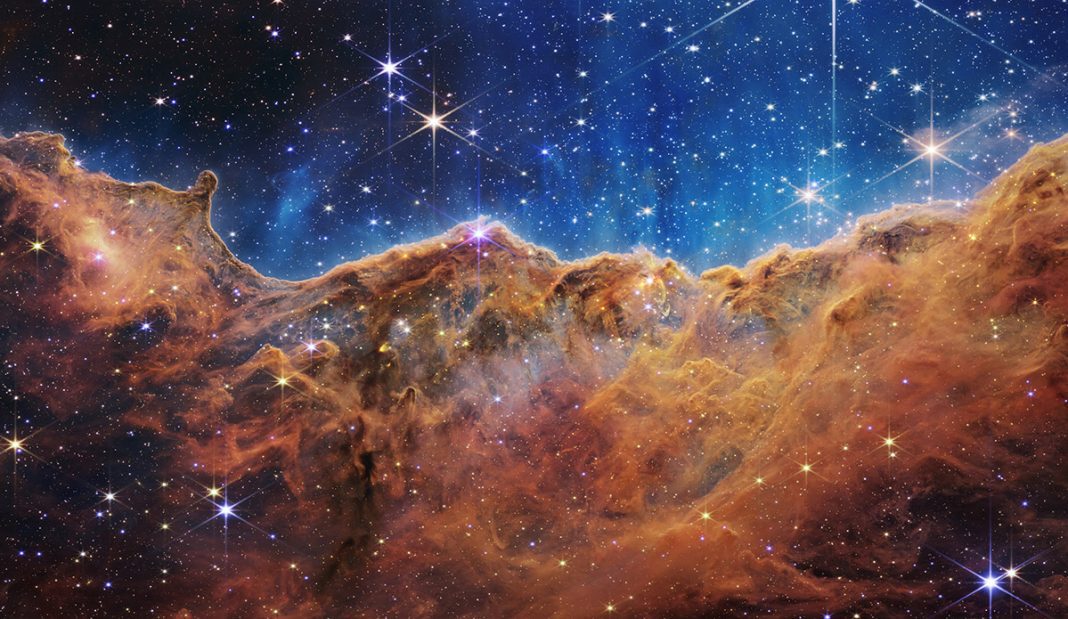A cradle of interacting stars and galaxies and a more accurate view of an exoplanet’s atmosphere: After the first “deep field” of the new James Webb Space Telescope, more stunning images are now showing its capabilities. Some “classics” such as the Carina Nebula or the Stephans Quintet galaxy cluster appear with unprecedented clarity. The telescope is also detecting water vapor in the spectrum of the exoplanet WASP-96b.
The James Webb Space Telescope is the largest and most complex astronomical instrument ever launched. But the effort was worth it: the first scientific images of the new telescope showed the performance of its optics and four instruments that operate primarily in the infrared and near infrared. US President Joe Biden had already presented the first image on the evening of July 11, 2022: the “first deep field” – the deepest and most accurate infrared image of the distant universe to date.
NASA has now released more first images of the Webb Telescope. The target elements and decorations were chosen in such a way as to best illustrate the versatility and possible uses of the telescope. “Through the James Webb Space Telescope, we are offering humanity a new view of the universe – perspectives the world has never seen before,” said NASA Administrator Bill Nelson.

Look at the atmosphere of a planet outside the solar system
An example of this is the telescope’s first mission of the near-infrared and slit spectrograph (NIRISS). This instrument is specifically designed to smash the light spectrum of exoplanets and other cosmic bodies. The NIRISS instrument can separate wavelengths of light down to one-thousandth of a micrometer and detect even the tiniest differences in brightness. At 0.6 to 2.8 microns, its spectral range extends further into the infrared than other spectrophotometers.
This makes the Webb telescope particularly well suited for detecting particles such as water, oxygen, methane or carbon dioxide in the atmospheres of exoplanets — and potential indicators of extraterrestrial life. Neres’ first target was the exoplanet WASP-96b, 1,150 light-years away, a gaseous planet about half the mass of Jupiter. As this planet passed in front of its star, the telescope was able to analyze the absorption lines left by the atoms and molecules of the planet’s gaseous envelope in the star’s light spectrum.
Among other things, spectroscopy reveals that the atmosphere of this exoplanet contains abundant water vapor. With a good surface temperature of 530 degrees, this gaseous planet is probably not very hospitable.
“Classic” in a new light
Another image from the James Webb Telescope shows a real “classic”: the Carina Nebula, 7,600 light-years away. Featuring glowing gases, hot young stars, and star-forming regions, this nebula has been imaged frequently by the Hubble Space Telescope. The Webb Telescope’s Medium Infrared Instrument (MIRI) instrument now shows clouds of hot dust, ionized gases and particles in glowing clouds more clearly than ever before.
The James Webb Telescope now makes it possible to visualize more details about star formation and thus elucidate the associated processes and feedbacks. The new image shows the edge of the expanding “bubble” in the glowing gas from young stars at the top of the image. As gases in the edge region are compressed by these processes, new stars can form as a result of the collapse of dense gas clouds.

Galaxy Crash
And there is another “classic” among the first images taken by the James Webb Telescope: Stephen’s Quint. This formation of five galaxies provides astronomers with an opportunity to study the interactions of such star groups in more detail. Because four of the five galaxies are so close together that they collide and affect each other in their star formation, gas distribution, and behavior. This is evident, among other things, in the long gas tails of some of these galaxies and the shock waves in some of them.
The composite image of data from the Near Infrared Spectrometer (NIRSpec) and the Mid-Infrared Instrument (MIRI) also shows for the first time the fine details of these galaxies, which are about 290 million light-years away. The fifth galaxy NGC 7320 on the left is only 40 million light-years away, and therefore appears to belong only to the quintuple. In it, Webb’s image makes individual stars visible.
The latest new image from the James Webb Telescope shows a planetary nebula – what’s left of a star like our sun when it completes its life cycle. The image shows NGC 3132, also known as the Southern Ring Nebula due to its ring-like shape, which is about 2,500 light-years away. Images from NIRCam and the MIRI instrument now reveal for the first time that one of the two central stars in this system is surrounded by a dense crust of dust.
The James Webb Space Telescope will now begin its regular science operations and should continue to provide many unique sights and new insights in the coming weeks, months and years.
These: NASA / STScI

“Unapologetic pop culture trailblazer. Freelance troublemaker. Food guru. Alcohol fanatic. Gamer. Explorer. Thinker.”




